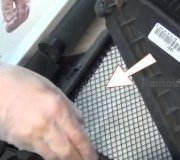Wednesday of last week I drove through about 6 to 12 inches of water on the freeway at about 55 MPH. Immediately after this unexpectedly large puddle, the engine started to run rough. There was quite a bit of vibration and it sounded much louder, almost like a modified exhaust (though the exhaust is stock). I pulled off at the next exit and took a quick look at the air intake -- no signs of water there. I let the engine idle for a few minutes and revved it a few times -- no change, still rough but running nonetheless. The engine continued to run rough through the remainder of the week and into the weekend, although I did not drive it anywhere except home after the incident and only started and revved it a bit once a day.
Over the weekend I opened the air filter box and took a closer look at the air intake. There was a layer of dust throughout the intake duct up until the air filter and the filter was dry, so obviously no water had been through the air intake.
I suspect that some water got into some of the electronics, although I haven't been able to determine where. Checked for trouble codes with a scanner -- there were none. Checked all of the fuses with a multimeter -- all were good. Checked the voltage across the terminals of the camshaft position sensor (CPS) connector -- good. I would have liked to check the voltage across the CPS with the engine running but could not connect the multimeter to the CPS while the connector was connected so instead I tried running the engine with the CPS disconnected to see if there was any difference. There was, the engine would not start, so I believe the CPS is ok. Checked for a misfiring cylinder due to a bad ignition coil or fuel injector, but the results so far have been inconclusive. Checked all cylinders with an IR thermometer (a cooler cylinder would indicate that it is not firing) -- most cylinders warmed at similar rates and reached about 170 degrees F except the 3rd from the front on the driver's side which warmed slower and reached about 150 (slightly cooler but hotter than I expected for a misfiring cylinder). With the engine running, disconnected the connector on the ignition coil over each cylinder one at a time -- each seemed to change the sound of the engine slightly, but it was hard to tell. I think the computer quickly sensed the disconnected coil and adjusted the timing to compensate. A trouble code was produced for each connector that was pulled stating that there was an error in the primary and secondary circuit of the ignition coil. Gave up on that test and moved on. Removed the ignition coil from the slightly cooler cylinder and used a calibrated tester to check for a spark -- it sparked. Checked each coil's primary resistance on all cylinders -- good. Did not bother checking the voltage across the fuel injectors after reading the service manual's section on fuel injectors and the PCM (computer); supposedly the computer would show a trouble code if the engine is running too rich/lean or misfiring.
I'm planning to pull the remaining ignition coils and test for sparks. The computer cannot detect a failure in an ignition coil's secondary circuit, so it's possible that one coil is not firing even though there are no trouble codes. If all coils are good I might even check the fuel injectors with a multimeter just to be sure that the computer isn't missing a malfunctioning fuel injector. Any other suggestions would be greatly appreciated.
Thanks!
Monday, October 25th, 2010 AT 3:13 AM


